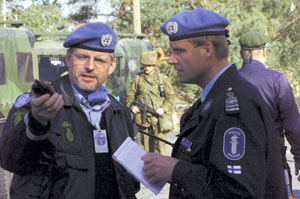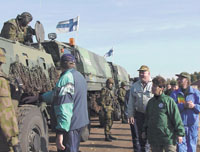Finland Lays Foundation for National Software-Defined Radio
 |
| Military and civil organizations such as the police departments that use the Terrestrial Trunked Radio, or TETRA, will use the Finnish Software Radio Program (FSRP) radio to bridge their different networks to support domestic operations, including disaster relief. |
The Finnish Software Radio Program is meeting the software-defined radio requirements of a nonaligned nation and offering insight into alternative approaches to the U.S. Joint Tactical Radio System. The program concentrates as much on equipping forces to fight in high-intensity conflict as it does on equipping them for smaller peacekeeping roles. Along with supporting allied forces’ equipment, it aims to support interoperability for disaster relief activities, nongovernmental organizations, and aid and emergency services work.
The program began in the 1990s with the Finnish army’s investigation of the potential of software-defined radios. The country’s navy sought solutions to improve its communications systems, including protecting them against electronic warfare attacks. In November 2002, the defense staff, recognizing the shared goals of the two efforts, combined both programs into the Finnish Software Radio Program (FSRP).
The FSRP is currently in its demonstrator phase. Work on the program is divided into three major subprojects. The tactical radio communications system (TRCS) comprises a software communications architecture (SCA) that complies with the software-defined radio platform and an antijam/low-probability-of-intercept, low-probability-of-detection waveform known as the adaptive wideband networking waveform (AWNW). The second subproject is the national tactical positioning system (NTPS) geolocation system. The third is an adaptive antenna system for the Finnish Defense Forces’ tactical communications requirements.
The FSRP is leveraging the same expertise used in commercially available cellular handsets. The University of Oulu Telecommunications Laboratory’s Center for Wireless Communications is working on the primary research contract, and Elektrobit Group PLC has been awarded the development contract. Other Finnish companies participating in the work include Sofnetix, PJ Microwave, Instrumentointi Oy, Secgo and Patria. Spectrum Signal Processing, a U.S. firm, is supporting Elektrobit’s work.
Finland’s industrial and research base has been employed to meet the country’s military communications requirements in the past. Earlier work included development of modified air defense datalinks for the Finnish Defense Forces, as the country’s unaligned status precluded it from access to NATO protocols. This led to the development of the National Tactical Data Link. A second-generation link currently is in service with Finland’s F-18 fleet, with a third-generation demonstrator now under construction. The air force will decide at a later date what role it will play in the FSRP.
The TRCS is at the core of the FSRP. It is a multiband, multimode platform operating the AWNW. The impact of the AWNW as an enabler for future operations is considerable, says Lt. Cmdr. Topi Tuukkanen, FI N, head of the Department of Naval Warfare, Finnish Naval Academy, and program manager, FSRP. “Even though the term ‘network-centric warfare’ is not adopted as such into the Finnish Defense Forces, there are various existing components, technologies and procedures that already provide such capabilities. However, AWNW will provide an adaptive broadband data transmission capability designed for hostile battlefield conditions, which opens up new possibilities to exercise command and control or even to develop new tactical and operational concepts. From this perspective, using software-defined radios with legacy waveforms only seems wasteful,” he says.
The AWNW will operate in three frequency-hopping very high frequency/ultrahigh frequency (VHF/UHF) modes: the peacetime operations mode with data rates of between 63 kilobits per second and 8 megabits per second, a lower probability of intercept/lower probability of detection mode with data rates between 1.5 kilobits per second and 63 kilobits per second, and an antijamming mode with data rates between 3.5 kilobits per second and 63 kilobits per second. Multiple access for users within a network and internetworking is achieved by using direct sequence, code division multiple access, space division multiple access and time division multiple access techniques. A fourth, super high frequency mode, called the high data rate link mode, is designed for air-to-ground and ground-to-ground communications and can achieve data rates of 16.384 megabits per second, although it allows only one user per network.
Initial production versions are likely to be rack-mounted on platforms. Cmdr. Tuukkanen sees manpack and handheld software-defined radios as possibly composing the second generation of Finnish software-defined radio equipment. Current manufacturing and component technology does not provide the sampling and processing power most advanced waveforms require. He adds that it would be quite possible that the first manpack and handheld software-defined radio would operate using only legacy waveforms or provide only limited electronic counter-countermeasures capability.
The NTPS provides a capability that is integral to the country’s neutral status, Cmdr. Tuukkanen explains. “The policy of credible, militarily nonaligned national defense necessitates that positioning services be independent of, let’s say, reluctant or even hostile to oversight. Furthermore, positioning service is actually a minor extension of the already specified communications waveform and as such can also be described as a service extension of the communications system,” he says.
The system leverages capabilities inherent to the TRCS demonstrator and the AWNW. The original NTPS studies began in 1997 before being folded into the FSRP. The TRCS element of the FSRP already provides precise timing to synchronize waveforms; it was found that this could be extended to support geolocation. The national tactical positioning waveform, a bandwidth-efficient waveform, is being included in the TRCS demonstrator. This is a VHF/UHF direct sequence, frequency-hopping solution that enables positioning accuracy of less than five meters. It operates in two main modes—the first with antijam protection, the second without. The latter consequently enjoys more precise two-dimensional location information and would be used domestically in peacetime and overseas in peace support operations.
The NTPS does not preclude the future use of satellite-based navigation systems. According to future schedules, Galileo is being earmarked for inclusion in series production software-defined radios for the army from the FSRP, and future versions may include a global positioning system (GPS) for joint use. Incorporation of GPS has been delayed to exploit future antijam technology for use with GPS.
 |
| A significant part of the FSRP aims to equip the Finnish Defense Forces for peace support operations. |
A key requirement for the antenna is that it cross-bands between civilian and military frequencies. These smart antennas allow transmitter and receiver antenna patterns to maximize effectiveness in hostile jamming environments.
JTRS is synonymous with software-defined radios, and the FSRP is required to be SCA compliant. Cmdr. Tuukkanen explains that unique circumstances, however, have led the Finnish Defense Forces to pursue different avenues than the United States has chosen. “The Finnish Defense Forces, being relatively small in size, may adopt much faster technology and generation changes with the equipment and materiel. Therefore, the JTRS emphasis on legacy waveforms that are not even releasable to non-NATO nations is not necessarily attractive for national defense purposes. Actually, the Finnish Defense Forces’ waveform specifications for the Finnish software radio are extremely demanding; the advanced electronic counter-countermeasures characteristics are one of the key technology areas being demonstrated. On the other hand, a limited set of legacy waveforms is needed to provide interoperability with coalition forces—for example, in peacekeeping operations.” He adds that the JTRS airborne/maritime fixed-cluster might be the best comparative program to the Finnish software-defined radio.
The FSRP’s demonstrator phase will continue until early 2006 when it will move to a two-year period of prototyping. The prototype stage will see the addition of new capabilities such as high frequencies and the ability to transfer data between dissimilar networks. These networks will link battlefield soldiers via the FSRP up the command information systems tree and will include Finland’s Tadiran Combat Net Radio and Terrestrial Trunked Radio (TETRA)—known locally as VIRVE—cellular networks used by the army, border security forces and other public safety organizations.
Beyond prototype development, series production is likely to begin toward the end of this decade, starting with the navy in 2009 and the army shortly afterward. “It is evident that, in the next decade, the majority of the military radios sold will be SCA compatible. The software-defined radio fits extremely well into existing procurement plans for the Finnish navy and army, and serial procurement is expected to begin in 2009 to 2010. The question of air force radio procurement is being dealt with as a part of the Finnish air force’s FA-18 Hornet midlife upgrade,” Cmdr. Tuukkanen says.
Key characteristics of series production radios will be the use of secure Internet protocol version 6, multiuser reception and an expanded frequency range, details of which have yet to be decided.
When fielded in army service, it is expected that the software-defined radio initially will be vehicle-mounted. The Finnish Defense Forces’ concepts for its use as a command information systems node for peace support operations show a wheeled armored fighting vehicle supporting mobile and static operations. This covers both military very high frequency and ultrahigh frequency communications and an array of civil telecommunications standards such as TETRA, Global System for Mobile communications and Third Generation Wireless, which are used by nongovernmental organizations and some militaries during peace support operations.
For mobile operations, several whip antennas will be used in addition to a base station for mobile subscribers in coverage range. In a static role, a large adaptive antenna array will be deployed, enabling the software-defined radio to act as both a bridge between heterogeneous networks and a relay for range extension. The FSRP recognizes that networking civil and military communications poses challenges for the protocol stack.
The FSRP is a multiphase program that involves several key technologies that need to be verified and validated during the demonstrator phase before even prototyping and procurement decisions can be made. Finland’s procurement laws require competition among industries. However, as Cmdr. Tuukkanen explains, “With these kinds of new emerging technologies, real competition might be difficult or at least limited.
“Furthermore, even though research and development results from the preceding work as well as the results of the demonstrator phase remain the property of the Finnish Defense Forces, it is evident that know-how and expertise accumulates only into those academic and industrial entities already involved with the software radio development. Therefore, until the software-defined radio marketplace evolves, the Finnish Defense Forces seek long-term partnerships for the design, development and manufacturing, possibly involving elements for lifetime maintenance also.”
Foreign participation is being actively sought, Cmdr. Tuukkanen adds. “The funding for research and development in the Finnish Defense Forces is limited. Therefore, international cooperation is being sought to share the burden of design, development and manufacturing,” he says.
Efforts to initiate such cooperation are now underway and may include government-to-government links leading to a harmonization of requirements and a sharing of the research and development workload. At an industry-to-industry level, subcontracted research, development and manufacturing could play a role, the commander says.
Adam Baddeley is a freelance technical writer based in the United Kingdom.




Comments